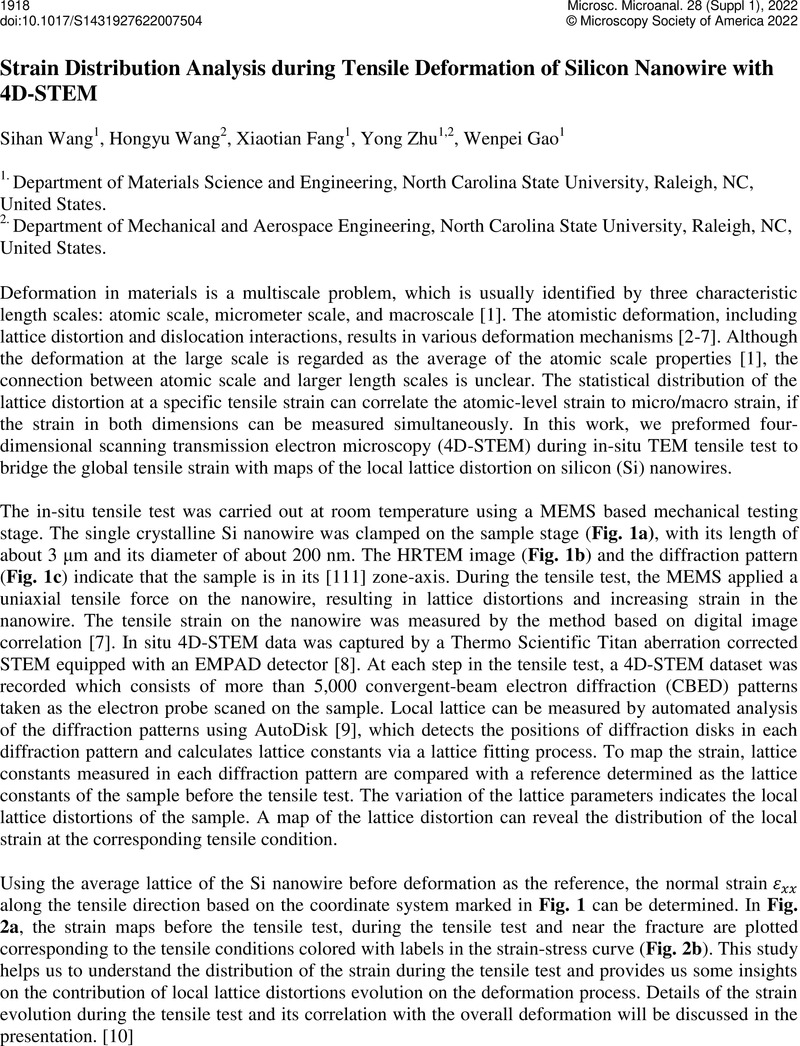No CrossRef data available.
Article contents
Strain Distribution Analysis during Tensile Deformation of Silicon Nanowire with 4D-STEM
Published online by Cambridge University Press: 22 July 2022
Abstract
An abstract is not available for this content so a preview has been provided. As you have access to this content, a full PDF is available via the ‘Save PDF’ action button.

- Type
- In Situ TEM Characterization of Dynamic Processes During Materials Synthesis and Processing
- Information
- Copyright
- Copyright © Microscopy Society of America 2022
References
Tang, A., Liu, H., Liu, G., Zhong, Y., Wang, L., Lu, Q., & Shen, …, Y. (2020). Lognormal distribution of local strain: a universal law of plastic deformation in material. Physical Review Letters, 124(15), 155501.CrossRefGoogle Scholar
Field, J. E. (1971). Brittle fracture: its study and application. Contemporary Physics, 12(1), 1-31.CrossRefGoogle Scholar
Kang, K., & Cai, W. (2007). Brittle and ductile fracture of semiconductor nanowires–molecular dynamics simulations. Philosophical Magazine, 87(14-15), 2169-2189.CrossRefGoogle Scholar
Zhu, Y., Xu, F., Qin, Q., Fung, W. Y., & Lu, W. (2009). Mechanical properties of vapor− liquid− solid synthesized silicon nanowires. Nano letters, 9(11), 3934-3939.CrossRefGoogle ScholarPubMed
Zhang, H., Fung, K. Y., Zhuang, Y., Cao, K., Song, J., Hu, A., & Lu, Y. (2019). Fracture of a silicon nanowire at ultra-large elastic strain. Acta Mechanica, 230(4), 1441-1449.CrossRefGoogle Scholar
Cheng, G., Chang, T. H., Qin, Q., Huang, H., & Zhu, Y. (2014). Mechanical properties of silicon carbide nanowires: effect of size-dependent defect density. Nano letters, 14(2), 754-758.CrossRefGoogle ScholarPubMed
Cheng, G., Zhang, Y., Chang, T. H., Liu, Q., Chen, L., Lu, W. D., & Zhu, …, Y. (2019). In situ nano-thermomechanical experiment reveals brittle to ductile transition in silicon nanowires. Nano Letters, 19(8), 5327-5334.CrossRefGoogle ScholarPubMed
Tate, M. W., Purohit, P., Chamberlain, D., Nguyen, K. X., Hovden, R., Chang, C. S., & Gruner, …, M, S.. (2016). High dynamic range pixel array detector for scanning transmission electron microscopy. Microscopy and Microanalysis, 22(1), 237-249.CrossRefGoogle ScholarPubMed
Wang, S., Eldred, T., Smith, J., & Gao, W. (2022). AutoDisk: Automated Diffraction Processing and Strain Mapping in 4D-STEM. Ultramicroscopy, 236, 113513.CrossRefGoogle ScholarPubMed
The electron microscopy was carried out at the Analytical Instrumentation Facility (AIF) at North Carolina State University, which is supported by the State of North Carolina and the National Science Foundation (award number ECCS-2025064). The AIF is a member of the North Carolina Research Triangle Nanotechnology Network (RTNN), a site in the National Nanotechnology Coordinated Infrastructure (NNCI).Google Scholar





